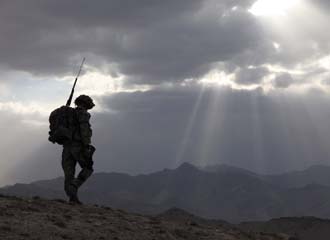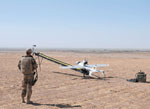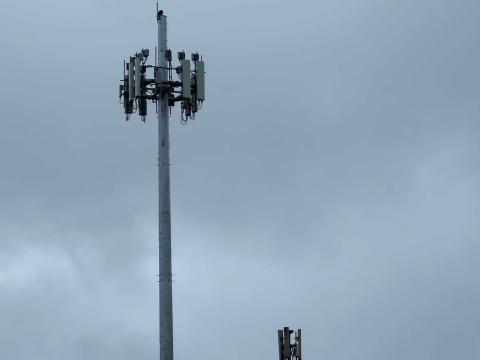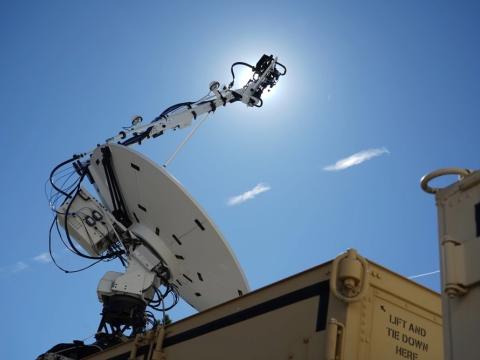Combat Communicators Bust Paradigms
 |
Specialist Newton Carlicci, USA, travels dismounted while returning to his outpost from the village of Paspajak, Charkh District, Logar province, Afghanistan. The complexities of coalition communication in Afghanistan are leading military forces to change existing paradigms. |
The complexities of communications in
The previous coalition norm was based on two fundamental facts: that only
In
The SIPRNET issue proved more difficult.
But the issues with SIPRNET went beyond granting access, Gen. Donahue explains. “The same standards that are applied to SIPRNET in my office in my garrison location are, in theory, expected to be complied with in a tactical environment. That’s an—uh—interesting proposition,” he states.
In addition, the military operates up to 30 networks in
The solution was to create the Afghan Mission Network, which is capable of handling secret information. The 30 networks feed information to, and pull information from, the Afghan Mission Network, which gives the regional commanders greater control over battlefield information and greater flexibility to use the forces under their command. The previous coalition network norm provided communications between the
But busting paradigms is a complex business. The military has eight critical mission function areas in Afghanistan that are being moved to the coalition network—joint battlespace management, joint fires, counter-improvised explosive device, freedom of maneuver, force protection, medical evacuation, a generic catch-all called combat applications, and intelligence, surveillance and reconnaissance (ISR).
“To move the fight to the coalition network required the movement of the eight critical mission functions—where the fight is fought—to the coalition network. To move the critical mission functions, you must move the applications that enable those functions. To move the applications, you must move the information that populates the applications,” Gen. Donahue explains. “This is the Afghan Mission Network—a means to fight a coalition fight with a tailored task organization of
 |
A German soldier operates a Luna aerial reconnaissance and surveillance unmanned aerial vehicle (UAV) in Mazar-e-Sarif, Afghanistan. In 2002, only a couple of Predator UAVs flew over the entire country of Afghanistan. Now, Predators are only one of many intelligence, surveillance and reconnaissance assets flying over the country daily. |
For the Afghan Mission Network to succeed, the military also had to shuck another norm—to transition from a Cold-War-era, need-to-know basis for sharing data to a need-to-share/right-for-release process. That need to share data with coalition partners drove the military to identify and begin working through the more than 400 obstacles to sharing information.
Those obstacles fall into three categories: technical; policy and cultural; and tactics, techniques and procedures. “I was fully expecting a lot of technical and policy obstacles. It turns out the problem was with tactics, techniques and procedures. When you combine that with the fact that 90 percent of the intelligence is generated from
The Afghan Mission Network is past initial operational capability and is expected to reach full operational capability before February. It has more than 50,000 users and is fed primarily by four networks owned by the
He insists, though, that the coalition network will in no way replace SIPRNET, because some information will always be releasable only to
The complexity of communicating in
Three regional commanders—a U.S. Army division commander, a U.S. Marine expeditionary force commander, and a German division commander—placed their G-6 officers or C4 directors in charge of network operations. One British two-star commander, who has no division G-6, chose his expeditionary signal battalion commander to lead network operations. Each network operations lead has the regional commander’s authority to operate on his behalf. “If you are the network operations element lead, that means you have the authority of that regional commander for all U.S. C4, U.S. ISR and coalition network resources,” Gen. Donahue says. In the region under the command of the German officer, a U.S. expeditionary signal battalion commander is responsible for U.S.-controlled command, control, communications, computers, intelligence, surveillance and reconnaissance (C4ISR), but not the coalition piece, he adds.
The role of network operations element lead is no great stretch for the G-6 officers, but it is a major change for the expeditionary signal battalion commanders. “It was an about-face and double-time for the expeditionary signal commanders, who had to adjust to take on that role,” Gen. Donahue explains.
Also of note, he says, is that the 25th Signal Battalion, which is a strategic-level battalion and does not normally become involved in day-to-day combat operations or have a direct effect at the tactical level, has changed its mission description. “They had to significantly change the way they did business because they have one company in direct support of each regional commander. And if that battalion’s focus is at the combined/joint operations area level, if that regional commander owns everything in his battlespace, you have a strategic company contributing to that battlespace.”
The Signal Corps is more involved in the fight in other ways as well. Network operators now are responsible for ensuring, for example, that a network failure does not lead to a slow response for medical evacuation or close air support. They have a more direct operational impact on the critical mission functions, and their effect is just as profound as the individual providing indirect fires, or performing other more traditional combat missions, Gen. Donahue explains. “It’s no longer just support to the warfighter. We are the warfighter in this cyber domain. We’re as much a warfighter as anyone else these days.”
WEB RESOURCES
International Security Assistance Force–Afghanistan: www.isaf.nato.int/leadership.html




Comments